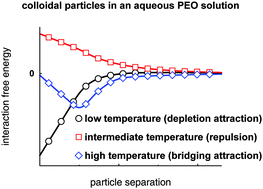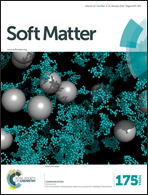Non-monotonic temperature response of polymer mediated interactions†
Abstract
In a recent publication, Feng et al. [Feng et al., Nat. Mater., 2015, 14, 61] reported a very interesting re-entrant solidification behaviour of colloidal particles in an aqueous solution containing polyethylene oxide (PEO). In this system, a crystalline colloidal phase, which is present at low temperatures, melts to a homogeneous fluid upon increasing the temperature. Further raising the temperature, however, eventually gives rise to a flocculated colloidal phase. Feng et al. proposed that the low-temperature crystalline phase is caused by polymer depletion while, at higher temperature, an increased attraction between polymers and particles leads to bridging attractions, and colloidal flocculation. The intermediate temperature regime sees the colloidal interactions dominated by charge repulsion, giving rise to a fluid phase. In the model by Feng et al., polymers are treated as hard spheres, which interact with the colloids via a phenomenological, temperature dependent potential. In this work, we develop a more detailed polymer density functional treatment, based on a model for aqueous PEO solutions that was originally developed by Karlström [Karlström, J. Phys. Chem., 1985, 89, 4962] for bulk solutions. In this model, monomers are assumed to be in either of two classes of states, labelled A and B, where B is more solvophobic than A. On the other hand, the degeneracy of the B states exceed that of A, causing the population of solvophobic monomers to increase with temperature. If the colloidal particles are also solvophobic, then this model displays the same qualitative temperature response as was observed by Feng et al. That is, at low temperatures, A type monomers predominate and one observes depletion interactions, whereas polymer bridging dominates at higher temperatures, due to the attraction between B-type monomers and the colloidal surface. Interestingly, the intermediate temperature regime is characterized by a polymer mediated interaction between colloids which is repulsive. That is, according to our model the homogeneous fluid phase would form even in the absence of repulsive electrostatic interactions. We emphasize that our model does not rely upon any temperature-dependent interactions. Furthermore, all possible polymer configurations are accounted for, subject to a mean-field Boltzmann weight. Finally, we show that interactions between colloids, mediated by neutral non-grafted polymers, generally follow the trend: attraction ⇒ repulsion (or vanishing interaction) ⇒ attraction as the surface affinity toward monomers proceeds from repulsive to attractive.


 Please wait while we load your content...
Please wait while we load your content...